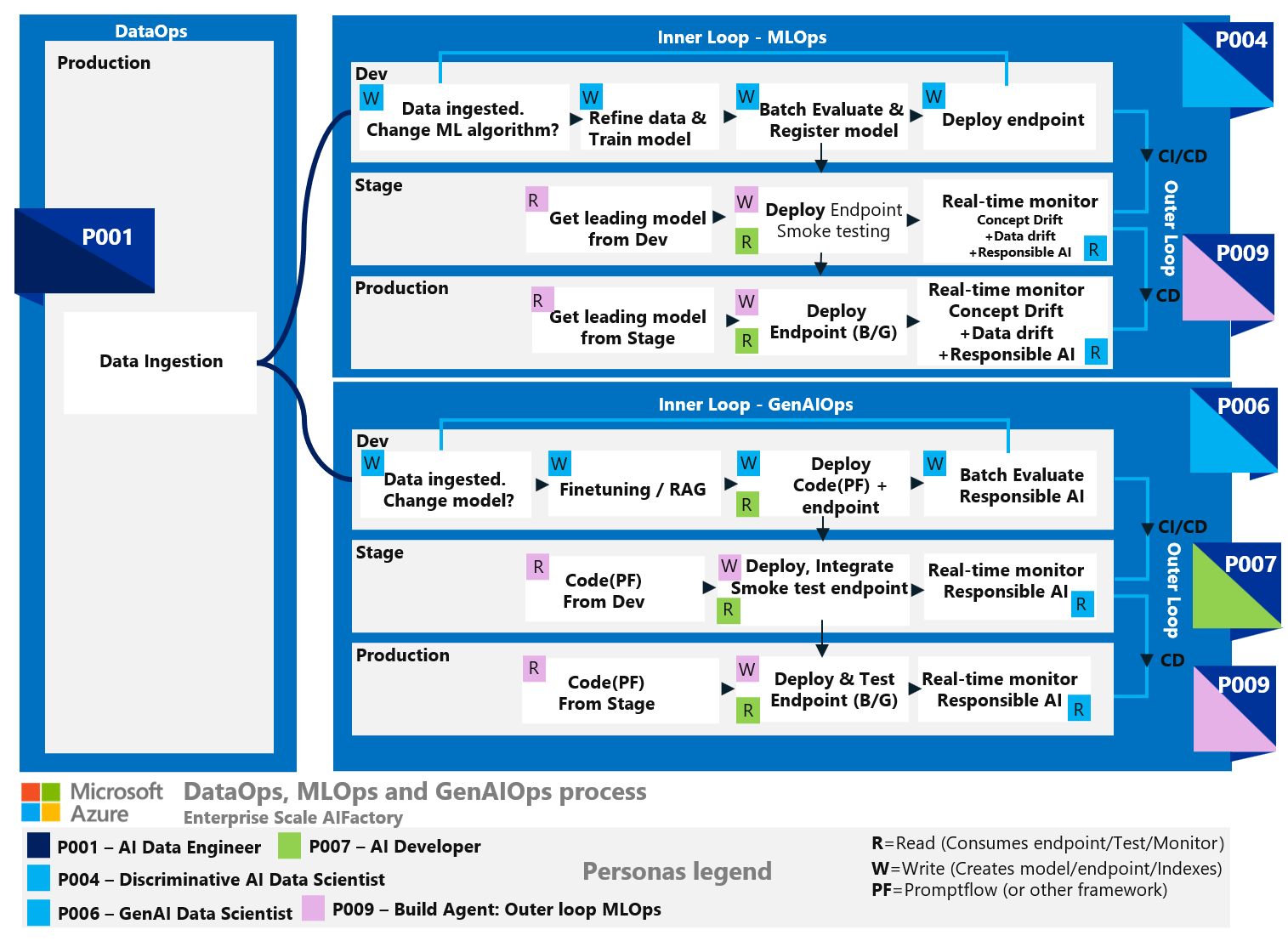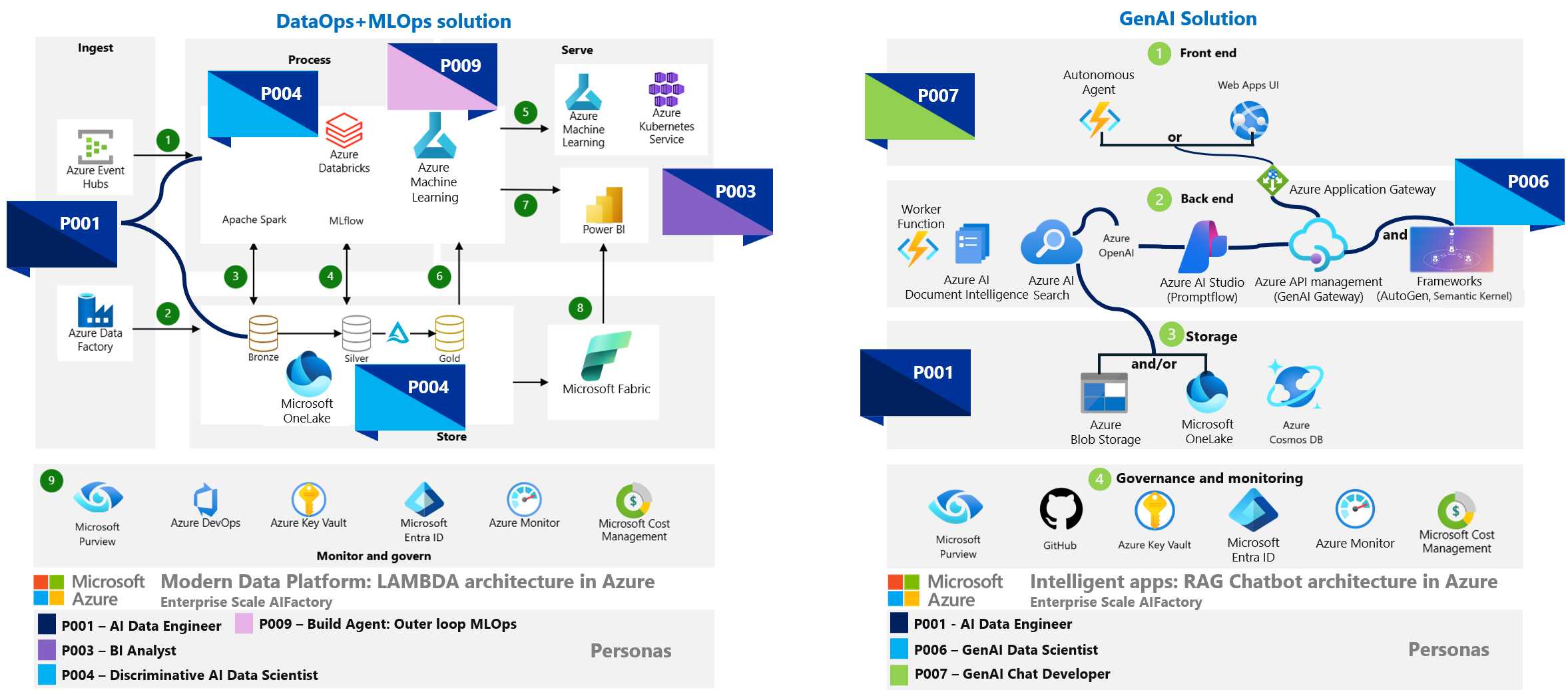Workload team personas for AI workloads
In the context of building AI workloads, in contrast to traditional code deployment, nondeterministic models require iterative experimentation and collaboration across multiple roles and teams. Early integration of operations, application development, and data teams is essential to foster mutual understanding. This collaboration demands diverse skills and continuous learning to keep pace with technological advancements.
Effective collaboration hinges on integrating tools, processes, and people and is driven by workload needs and specific goals. The recommended strategies include:
- Establishing clear roles and accountabilities.
- Taking advantage of your team's skill set for appropriate tasks.
- Standardizing processes and subprocesses, such as tracking work as part of a shared backlog.
- Relying on automation to achieve consistency and reproducibility.
Personas can be an effective tool for materializing those strategies and standardizing responsibilities. This article describes the personas for AI workloads and their benefits in workload design. It also provides examples and tools for defining and using these team-level personas effectively.
What are personas?
Personas represent subsets of humans and processes that are involved in the creation and operation of a workload. Personas capture both the roles and the real behaviors and accountabilities of these individuals and processes. An individual can embody one or multiple personas, depending on context. A persona doesn't have to be a person. It can also be an unattended process, such as an agent process in the architecture.
Your workload might have user personas that drive feature development. Those personas aren't in scope for this article.
Unlike roles, which are relatively static functions or positions within an organization, personas are dynamic and goal oriented. They can be used to map skill requirements to processes and tools, like architectural components. Personas primarily help define the scope of responsibility and set context within a project. They provide several other benefits, such as:
- Identification of resource gaps. Identifying gaps helps you decide whether to recruit or train resources or redesign the solution. If your workload team lacks individuals that fit a necessary persona, you might need to adjust the architecture, modify the process, or onboard new personnel. For example, if a senior data science persona is missing, you can redesign the architecture to rely more on general-purpose software as a service (SaaS) AI solutions or incorporate non-Microsoft AI solutions.
- Enhanced skills. Mapping personas to specific architectural components also facilitates educational opportunities, like sessions and online courses to enhance skills.
- Ensuring appropriate levels of access. You should use personas to define security and access needs by mapping personas to processes, architectures, and services. This mapping helps to ensure appropriate access levels.
- Facilitating project planning and communication. In project planning, personas help identify key interactions to facilitate the setup of sync meetings and overall planning. Typically, personas are integrated into the hierarchy of tracking user stories, features, and requirements to streamline project management.
How to define personas
Identify your team members' specializations and align them with the appropriate roles in your AI operations or design. Create a template to document personas' skill expectations, team information, and the processes in which they'll be involved.
Here's an example baseline template:
| Persona template |
|---|
| 🔹Persona name: [Name] 🔹Team: [Team responsible for the persona] 🔹Primary interaction: [Other teams the persona interacts with] 🔹Component access: [Security and access requirements for processes and system components] 🔹Processes: [Processes the persona is responsible for or contributes to] 🔹Skills: [Skills required to complete the tasks, including domain and technology specifics like model training or search index optimization] |
Tools
You can use a table to organize and visualize information for each persona. One advantage to this method is that you can create and link to other tables that provide more specific information. For example, you can link architecture components to another table where identity-based access control is specified for each service and environment (Dev, Stage, Production).
Tradeoff. Having too few personas can make it difficult to implement role-based access control with least privileged access and to distribute work responsibilities effectively. Conversely, having too many personas adds management overhead. Starting with between 5 and 10 personas is a good balance, and you should only add personas that are necessary for your operations.
You can also use cards to define personas. These cards contain the same information as the table, or a quick summary. You can use PowerPoint or make a set of Markdown files to create these cards.
In certain cases, you can use a combination of tools. For example, each architecture component in a persona card can open a Markdown file that includes a table that maps security and role-based access control for each service and environment. For an example, see MLOps accelerator: Identity RBAC.
Example personas
You can use cards to define the services a persona needs to be able to access within a process and outline the skills required for each persona (whether it's a person or an agent).
Important
Although the personas defined here serve as baseline examples, we recommend that you create your own personas by using tools like tables, persona template cards, and graphs.
It's important that these personas align with your processes, organization, and users.
| AI Data Engineer (P001) |
|---|
| Team: Data Ingestion Team 🔹 Primary interaction: AI Development Team 🔹 Component access: Azure Data Factory, Azure Databricks, Azure SQL Database, Azure Storage 🔹 Processes: DataOps, ETL, ELT 🔹 Skills: SQL, Python, PySpark |
| BI Analyst (P003) |
|---|
| Team: Analytics Team 🔹 Primary interaction: Data Ingestion Team 🔹 Component access: Power BI, Azure Data Explorer, Azure Storage 🔹 Processes: Data analysis, data warehousing 🔹 Skills: SQL, Python, PySpark |
| Discriminative AI Data Scientist (P004) |
|---|
| Team: AI Team 🔹 Primary interaction: Data Ingestion Team, DevOps Team 🔹 Component access: Azure Machine Learning, Azure Databricks, Azure Storage, Azure Key Vault 🔹 Processes: MLOps, MLflow 🔹 Skills: Azure Machine Learning, Python, Model training |
| GenAI Data Scientist (P006) |
|---|
| Team: AI Team 🔹 Primary interaction: Data Ingestion Team, DevOps Team 🔹 Component access: Azure AI Foundry portal, Azure OpenAI Service, Azure AI Search, Azure Storage, Azure Key Vault 🔹 Processes: GenAIOps 🔹 Skills: Azure Machine Learning, Python, model knowledge (LLM, SLM), fine-tuning, RAG, agentic concept |
| GenAI Chat Developer (P007) |
|---|
| Team: Engineering Team 🔹 Primary interaction: AI Team 🔹 Component access: Azure Web Apps, Azure API Management, Azure Cosmos DB, Azure Container Apps, Azure Functions 🔹 Processes: DevOps, event-driven processing, microservices 🔹 Skills: Web application architecture (front end/back end), React, Node.js, HTML, CSS |
| Build Agent MLOps (P009) |
|---|
| Team: Engineering Team 🔹 Primary interaction: AI Team 🔹 Component access: Azure Machine Learning, Azure DevOps, GitHub 🔹 Processes: Processing and serving of Lambda, outer loop MLOps 🔹 Skills: Python, Pyspark |
Use case: Personas for AI processes
These main processes are used in AI workloads:
- DataOps is the ingestion and preparation of data.
- MLOps is the operationalization of machine learning models.
- GenAIOps is the discovery and evaluation of existing models and the refinement of these models to the workload context.
- Inner loop is the refinement of solutions in the development environment, either during research or as triggered by outer loop monitoring.
- Outer loop is the movement of solutions from development to production. This loop uses continuous monitoring and evaluation to identify necessary improvements.
Mapping personas to those processes provides context for each persona. This step can help identify the processes where a persona might need upskilling.
The image shows the workflow for DataOps, MLOps, and GenAIOps within a production environment. Data flows from ingestion to model deployment and evaluation. The workflow uses continuous integration and continuous delivery (CI/CD) practices. Key tasks include refining data models, evaluating batches, deploying endpoints, evaluating models in real-time, and fine-tuning models. The example personas participate in the entire workflow.
Use case: Personas for architecture design
Connecting processes to the supporting architecture helps you identify the services that a persona needs to interact with and highlights areas for potential upskilling.
To visualize this connection, create a graphical image that shows how architecture components are connected. This visual aid can illustrate data flow and interactions between services and how flows are automated in deployment. It helps stakeholders understand the architecture and the roles of different personas within it.
The following image shows a Lambda architecture for modern analytics on Azure.
Next step
Next, proceed to the assessment tool to evaluate your design.

